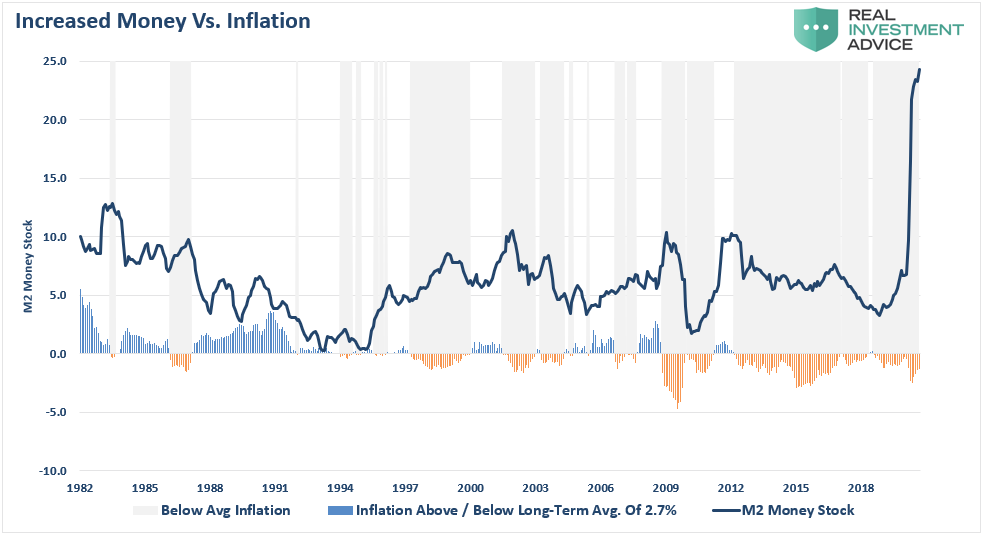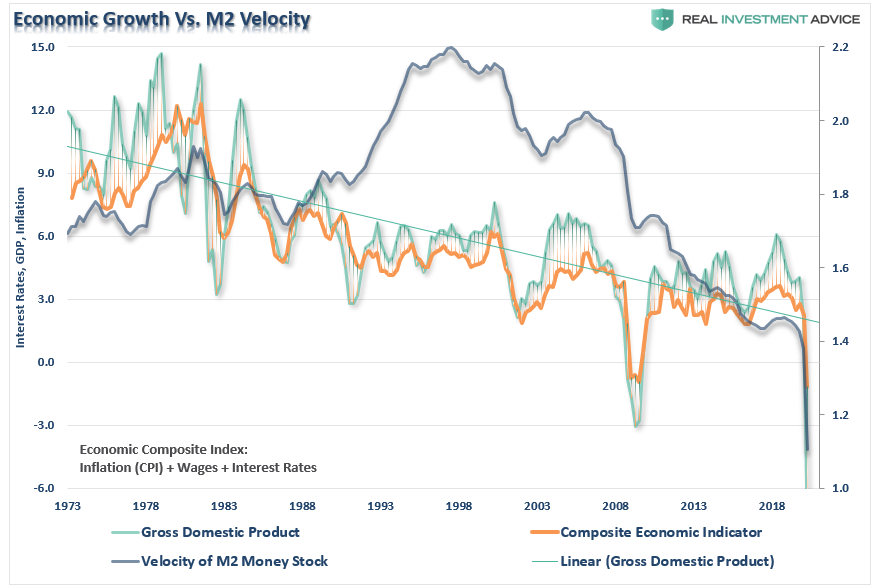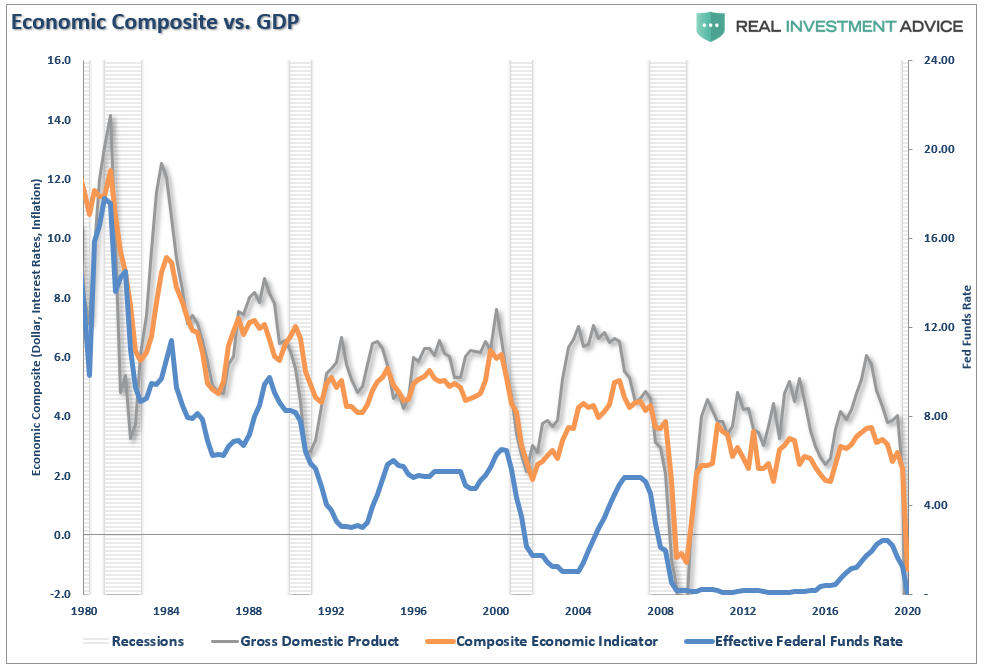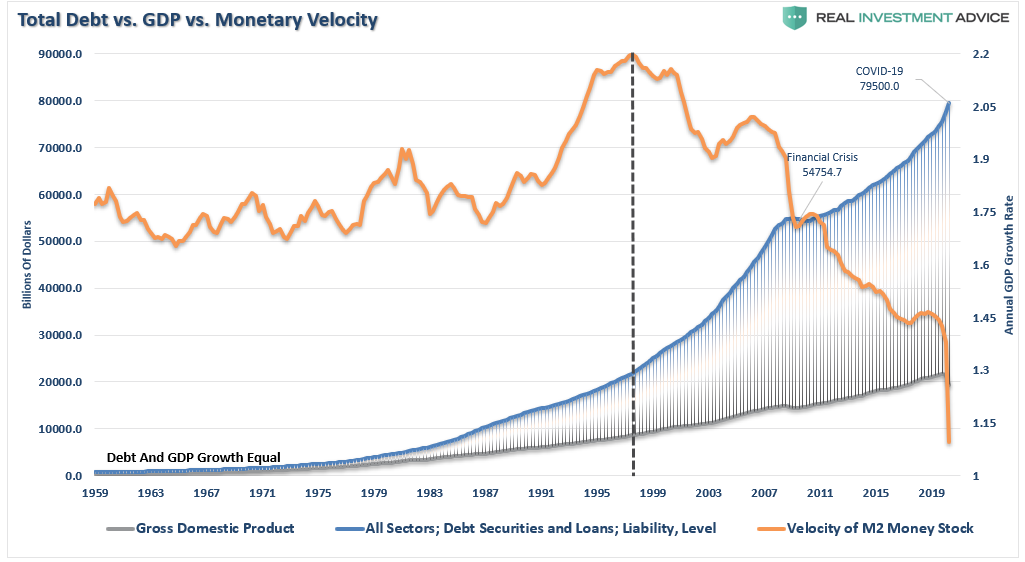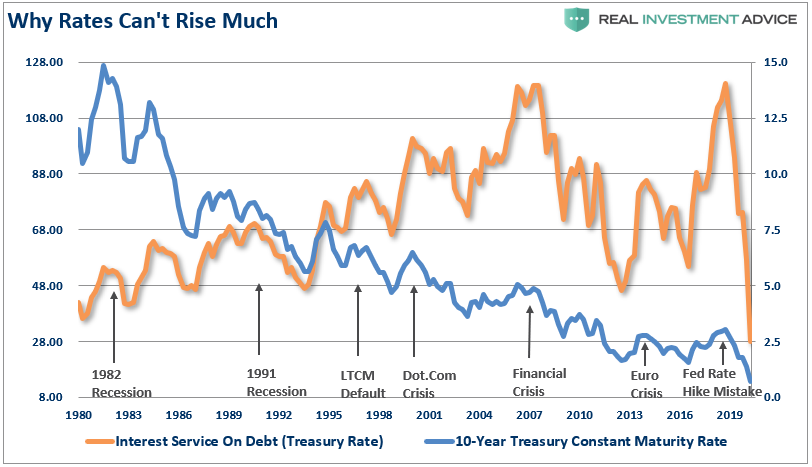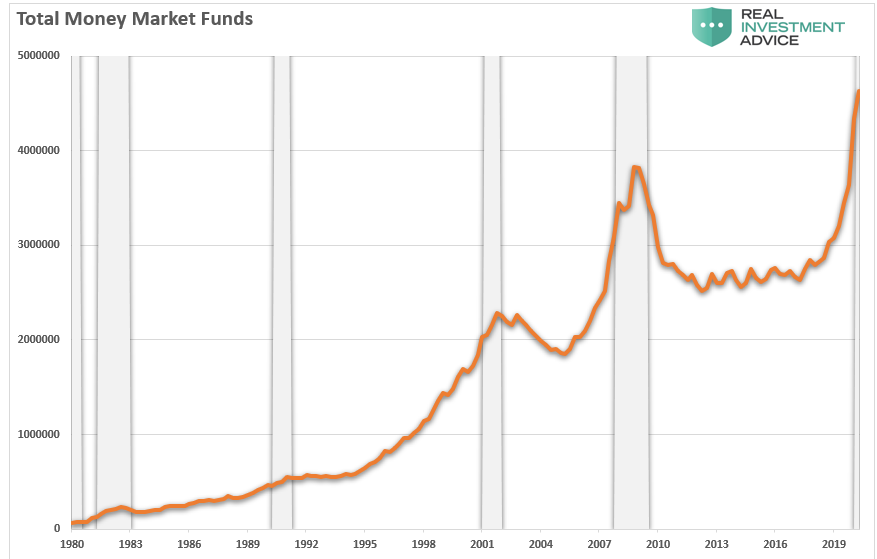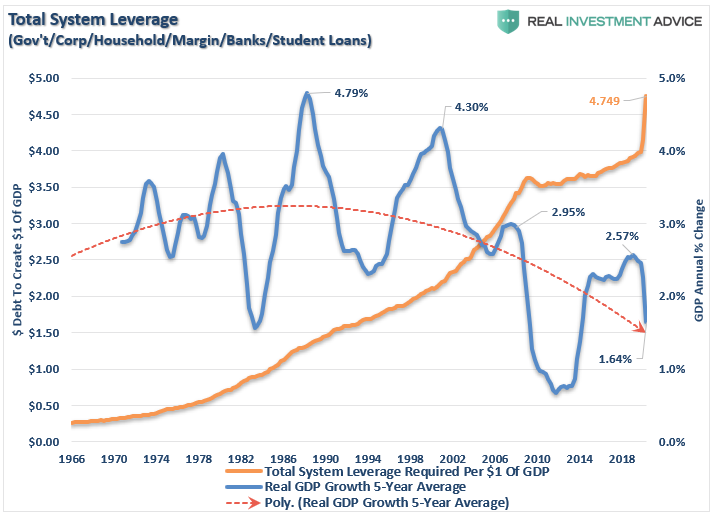There has been a rising concern as of late about surging inflation as the Government injects more stimulus into the economy. While it seems logical, the reality will be quite different as weak economic growth rates force the Fed to monetize the entirety of future debt issuances.
The Inflation Premise
To fully explain why the Fed is now trapped, we must start with the inflation premise. The consensus expectation is the massive increases in monetary stimulus will spark inflationary pressures. Using the money supply as a proxy, we can compare the money supply changes to inflation.
What we find is since 1980, increases in the money supply tend to precede periods of below-average inflation. Such tends to contradict the mainstream belief that increases in the money supply will lead to hyper-inflation due to the currency’s devaluation.
Collapse Of Velocity
Such has not been the case since 1990 as the byproduct of the money supply, known as “monetary velocity,” has been non-existent. As discussed previously:
“The velocity of money is important for measuring the rate at which money in circulation is used for purchasing goods and services. Velocity is useful in gauging the health and vitality of the economy. High money velocity is usually associated with a healthy, expanding economy. Low money velocity is usually associated with recessions and contractions.
In each monetary policy intervention, the velocity of money has slowed along with the breadth and strength of economic activity.”
The chart below shows the problem. Despite increases in the money supply, the “velocity of money” has plunged along with economic growth. The “economic composite,” which tracks GDP, comprises the components derived from “economic growth,” namely wages, inflation, and interest rates.
The question we must address is, “what happened in 1998” caused monetary velocity to collapse?
Fed Has Crossed The Rubicon
We often assume that “bad outcomes” happen overnight. Such is not the case.
Whether it is the outbreak of war, an economic recession, or a “bear market,” there is always a long-period of events leading up to the crisis. As is often stated, “a crisis happens slowly, then all at once.”
Such is the “trap” the Federal Reserve finds themselves in today. In 1980, the Federal Reserve became active in monetary policy, believing they could control economic growth and inflationary pressures. Decades of their monetary experiment have succeeded only in reducing economic growth and inflation and increasing economic inequality.
However, in 1998, the Federal Reserve “crossed the ‘Rubicon,’ whereby lowering interest rates failed to stimulate economic growth or inflation as the “debt burden” detracted from it. When compared to the total debt of the economy, monetary velocity shows the problem facing the Fed.
Look closely at the chart above. From 1950-1980 the economy grew at an annualized rate of 7.70%. The total credit market debt to GDP ratio was less than 150% to accomplish this growth rate. The CRITICAL factor to note is that economic growth was trending higher during this span, rising from roughly 5% to nearly 15%.
There were a couple of reasons for this. Lower levels of debt allowed for personal savings to remain robust, fueling productive investment in the economy. Secondly, the economy focused primarily on production and manufacturing, which has a high multiplier effect on the economy. This growth feat also occurred in the face of steadily rising interest rates peaking with the economic expansion in 1980.
How did the Federal Reserve get themselves into this trap?
“Slowly, and then all at once.”
The Interest Rate Trap
One of the biggest problems over the last decade is why interest rates don’t rise. While all of the “bond gurus” have had an annual prognostication of “the death of the bond bull market,” it has yet to occur.
In an economy laden with $75 Trillion in total debt, higher interest rates have an immediate impact on consumption, which is 70% of economic growth. The chart below shows this to be the case, which is the interest service on total credit market debt. (The chart assumes all debt is equivalent to the 10-year Treasury, which is not the case.)
Importantly, note that each time rates have risen substantially from previous lows, there has been a crisis, recession, or a bear market. Currently, with rates at historic lows, consumers are rushing out to buy houses and cars. However, if rates rise to between 1.5 and 2%, economic growth will quickly stall.
The Federal Reserve is well aware of the problem and why they have been quick to reduce rates and increase bond purchases. Such is because higher rates spread through the economy like a virus.
The Rate Virus
In an economy that requires $5 of debt to create $1 of economic growth, changes to interest rates have an immediate impact on consumption and growth.
1) An increase in rates curtails growth as rising borrowing costs slow consumption.
2) As of October 1, the Fed now has $7.02 trillion in liabilities and $39.2 billion in capital. A sharp rise in rates will dramatically impair their balance sheet.
3) Rising interest rates will immediately slow the housing market. People buy payments, not houses, and rising rates mean higher payments.
4) An increase in rates means higher borrowing costs and lower profit margins for corporations.
5) Stock valuations have been elevated due to low rates. Higher rates exacerbate the valuation problem for equities.
6) The negative impact on the massive derivatives market could lead to another credit crisis as rate-spread derivatives go bust.
7) As rates increase, so do the variable rate interest payments on credit cards. With the consumer already impacted by stagnant wages, under-employment, and high living costs, a rise in debt payments would further curtail disposable incomes.
8) Rising defaults on debt service will negatively impact banks that are still not adequately capitalized and still burdened by massive bad debt levels.
9) The deficit/GDP ratio will surge as borrowing costs rise sharply.
I could go on, but you get the idea.
The Liquidity Trap
While the Federal Reserve keeps wanting higher inflation rates, which should correspond with economic growth, its policy actions continue to work to the contrary.
In theory, their actions should lead to higher inflation as low rates spur consumption and investment. However, a signature characteristic of a “liquidity trap” is:
“When injections of cash into the private banking system by a central bank fail to lower interest rates or stimulate economic growth. A liquidity trap occurs when people hoard cash because they expect an adverse event such as deflation, insufficient aggregate demand, or war.
Signature characteristics of a liquidity trap are short-term interest rates remain near zero. Furthermore, fluctuations in the monetary base fail to translate into fluctuations in general price levels.”
Pay particular attention to the last sentence.
As discussed through the entirety of this article, every “check box” of a liquidity-trap has gotten filled:
- Lower interest rates fail to stimulate economic growth.
- Short-term interest rates near zero.
- Fluctuations in monetary base fail to translate into general price levels.
- People hoard cash because they expect an adverse event (economic crisis).
Long-Term Evidence
Given that higher rates of inflation would also correspond with higher interest rates, such will negatively impact virtually every aspect of the economy. As rates rise, so do rates on credit card payments, auto loans, business loans, capital expenditures, leases, etc., while reducing corporate profitability.
In an economy supported by debt, rates must remain low. Therefore, the Federal Reserve has no choice but to monetize as much debt issuance as is needed to keep rates from substantially rising.
Unfortunately, higher levels of debt continue to retard economic growth keeping the Fed trapped in a debt cycle as hopes of “growth” remain elusive. The current 5-year average inflation-adjusted growth rate is just 1.64%, a far cry from the 4.79% real growth rate in the ’80s.
Deflation Still Present
The debt problem exposes the Fed’s risk and why they have no choice but to monetize the Government’s debt issuance to keep interest rates suppressed. More importantly, the decline in monetary velocity clearly shows that deflation is a persistent threat, and one the Fed is most afraid of.
Treasury&Risk clearly explained the reasoning:
“It is hard to overstate the degree to which psychology drives an economy’s shift to deflation. When the prevailing economic mood in a nation changes from optimism to pessimism, participants change. Creditors, debtors, investors, producers, and consumers all change their primary orientation from expansion to conservation.
- Creditors become more conservative, and slow their lending.
- Potential debtors become more conservative, and borrow less or not at all.
- Investors become more conservative, they commit less money to debt investments.
- Producers become more conservative and reduce expansion plans.
- Consumers become more conservative, and save more and spend less.
These behaviors reduce the velocity of money, which puts downward pressure on prices. Money velocity has already been slowing for years, a classic warning sign that deflation is impending. Now, thanks to the virus-related lockdowns, money velocity has begun to collapse. As widespread pessimism takes hold, expect it to fall even further.”
No Real Options
The Federal Reserve has no real options unless they are willing to allow the system to reset painfully.
Unfortunately, given we now have a decade of experience of watching monetary experiments only succeed in creating a massive “wealth gap,” maybe we should consider the alternative.
Ultimately, the Federal Reserve, and the Administration, will have to face hard choices to extricate the economy from the current “liquidity trap.” However, history shows that political leadership never makes hard choices until those choices get forced upon them.
While we continue to “hope” we can “grow” our way out of our debt problem, “hope” has never been a functional strategy for fixing problems.
Lance Roberts is a Chief Portfolio Strategist/Economist for RIA Advisors. He is also the host of “The Lance Roberts Podcast” and Chief Editor of the “Real Investment Advice” website and author of “Real Investment Daily” blog and “Real Investment Report“. Follow Lance on Facebook, Twitter, Linked-In and YouTube
Customer Relationship Summary (Form CRS)
Also Read








